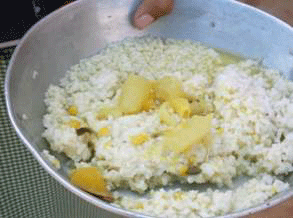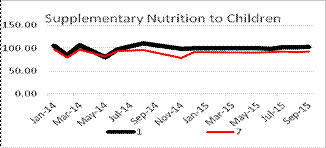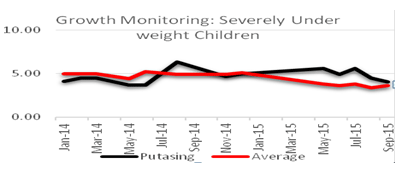Food Habits of Lanjia Saora and Nutritional Status of their Children
Shashank Grahacharjya
Abstract
Food is the most essential part of human existence. Food habits are developed with availability and accessibility of food. Dietary inadequacy and poor feeding practices lead to malnutrition. The PVTGs are at risk of under nutrition. Food habits of Lanjia Saora have changed. They have started distancing themselves from nutritious local millets over the years. External interventions through missionaries, government food schemes, and vibrant market force have led to the change. There are many food security (related) schemes being implemented in tribal areas. Due coordination amongst the departments and convergence of program interventions is required for effective outcome in field reality. Any single scheme cannot bring substantial and sustained positive change in isolation despite having excellent performance of its own. In spite of many interventions, continued supplementation of food to all children covered under ICDS in a Lanjia Saora dominated sector in Rayagada district, the number of severely underweight children were found to be more, as compared to others in the same block. Life style related diseases are affecting the tribals due to change in food habits and reduction in physical labor. Apathy to some traditional food craft, and exclusion of uncultivated foods from tribal food security policy framework may increase the dependency on external food aid, and endanger their coping mechanism.
The present study analyses the different schemes being implemented in the area and their impact upon the nutritional status of Lanjia Saora, and how they supplement and complement to the current food habits and dietary intake. It refers to secondary sources, and examines 60 families through a purposive non-random sampling. While stressing upon the need for effective coordination and convergence of various programme interventions, the study recommends a few steps to improve upon the programme implementation with focus in enhancing food and nutrition security of Lanjia Saora.
1. Introduction
Food is the most essential part of human existence. Human civilization has come up since its origin aligning on accessibility and availability of food - be it the promotion of agriculture for which a river bank was chosen for settlement or even (at pre-agriculture level/ stage) for hunting of animals or collection of fruits, roots and nuts, etc. in dense forest, human being has set priority to food for its survival and sustenance. Over the period, with availability and accessibility of various eatables at the physical and economic reach, human being has developed its food habits. Apart from these major factors, ethnicity, religion, values, socio-economic status, family background, education, health, technology, market trend (influenced through publicity), transport and physical convenience are other aspects that make people form their food habits. Hence, food habit is dynamic in nature by itself.
World is changing fast. Change is also inevitable. However, rate of change is comparatively slow and/ or delayed in case of tribal in general and Particularly Vulnerable Tribal Groups (PVTG) – (previously known as Primitive Tribal Groups (PTGs)) in particular, in India. PVTGs constitute the most vulnerable section among tribal. They inhabit isolated, remote and difficult areas in small and scattered habitats. Their geographical isolation, primitive agricultural practices, socio-cultural prohibitions, poor health seeking behavior, poverty, etc., lead them to various morbidities and undernutrition. Nutritional status of population largely depends on the consumption of food and its absorption in human body. The PVTGs are at risk of undernutrition because of their low dietary intake and poor access to health and sanitation facilities.
Report of the High Level Committee on Socio-economic, Health and Educational Status of Tribal Communities of India (May 2014), Ministry of Tribal Affairs, Government of India extensively referred to the three (repetitive) studies on ‘Nutritional Status and Food Consumption Pattern of Tribal Population,’ conducted by National Nutrition Monitoring Bureau (NNMB) of Indian Council of Medical Research (ICMR). The Committee concluded that, under-nutrition is still an important public health problem among tribal children and urgent strengthening in nutrition interventions and other programs focused towards food and nutrition security among the population are needed.
2. Objectives of the Study
The study has focused on various dimensions of food habits of PVTG i.e. Lanjia Saora in Rayagada district in southern Odisha. The study has attempted to explore:
-
What changes have the food security (-related) schemes brought into socio-cultural practices of PVTG, and how have the Lanjia Saora owned these schemes?
-
Have the Lanjia Saora developed apathy to the traditional food items, and how do they cope with food scarcity, if any, during difficult time?
-
What are the taboos associated with consumption and restriction of food items?
3. Methodology
The study is of exploratory in nature. It collected some specific quantitative data to complement with the qualitative observations.
Sampling
Purposive non-random sampling technique was used to 60 tribal households, who represented and reflected the diversity and breadth of the sample populations. Therefore, advance knowledge of the population under investigation was acquired from secondary sources including the government documents before carrying out the purposive sampling. The study reviewed available literature, contacted area and subject specialists, interviewed key government officials at state, district, block and Gram Panchayat (GP) levels, referred to demographic profiles, and observed the behavioral, attitudinal and socio-emotional priorities of the PVTGs, especially women, in their respective habitats. Control measures were taken to restrict the study to a relatively small number of sample size. Control group was from the nearby habitation, which has almost the same government flagship food, and nutrition related program activities, excepting the ones that are rendered to the subject (study) group under the special micro project. Many determining causes, influencing factors, ever expanding dimensions of food and nutrition security are not deliberated here in this paper which would have otherwise enhanced the existing intricacies of the topic.
Data Collection
Open interviews with respondents were held at their own set up/locale to capture in the wider range of the complex issues. The subjective indicators were measured through qualitative investigations with logical statistical augmentation of the findings. While a semi structured interview schedule was designed and administered amongst the respondents as reference tool for data collection, focus group discussions, intensive interactions with individuals, on the spot observations, participatory rural appraisal (PRA) exercises, etc. were adopted for more productive and manageable data analysis. Support of translators (local youth) was taken as and when required during the field survey.
The study collected and analyzed data pertaining to growth rate and nutritional status of children below six years of age vis-à-vis coverage of beneficiaries under supplementary nutrition in Integrated Child Development Services (ICDS) project, Gunupur with focus on Puttasing sector having 30 Anganwadi Centers (AWCs) of which 16 are from Puttasing GP and 14 from Sagada GP. Sagada is under the Lanjia Saora Development Micro Project (LSDA), which has its office in Puttasing.
|
Why Integrated Child Development Services (ICDS)? - Amongst the plethora of food aid schemes of government, ICDS is undoubtedly the one that has an in-build mechanism of measuring nutritional outcome on regular basis (against the package of services provided as inputs directly to the end users). Nutritional status of children and women is considered as an important indicator of food and nutrition security. ICDS being a flagship program of the government contributes a lot to the social safety net. |
Additionally, a one-day 24-hour recall method of diet survey was carried out to assess the food and nutrient intakes of the households. Their dietary diversity was measured. Dietary diversity is a qualitative measure of food consumption that reflects household access to a variety of foods, and is also a proxy for nutrient adequacy of the diet of individuals.
The household dietary diversity score (HDSS) is used to measure and reflect, in a snapshot form, the economic ability of a household to access a variety of foods. An increase in dietary diversity is associated with socio-economic status and household food security.
4. PVTG in Odisha
About 9.2% of India’s ST population live in Odisha, which is the third highest in the country. Madhya Pradesh (14.7%) and Maharashtra (10.1%) are the two states ahead of Odisha with respect to ST population. 9.6 million STs constitute 22.91% of the total population (41.9 million) of Odisha. Census (2011). The sex ratio in tribal population in Odisha has risen from 1003 in 2001, to 1029 in 2011, and is above than the national average of 990 for STs. The literacy rate of STs in Odisha has significantly increased from 23.4% in 2001 to 41.2% in 2011, though continued to remain lower than the national average of 47.1% for ST. Female literacy, though increased encouragingly, but still remains poor in many tribal areas, especially in case of PVTGs (e.g. Dongria Kondha - still a single digit- though the sex ratio is comparatively much higher than others, amongst tribal, i.e., 1352 females per 1000 Dongria Kondha males).
Since 5th Five Year Plan, with the adoption of Tribal Sub Plan (TSP), Government of Odisha (GoO) has identified Bonda, Birhor, Didayi, Paudi Bhuyan, Lanjia Saora, Hill Kharia, Mankirdia, Kutia Kondh, Dongria Kondh, Juang, Chuktia Bhunjia, Lodha and Saora as 13 PVTGs. GoO has 17 Micro-projects for these 13 PVTGs at their respective scattered habitations, spread across 12 out of 30 districts of Odisha, to bring about their all-round development.
Odisha has the largest number i.e. 13 out of 75 PVTGs in the country. Odisha occupies 10th position in India as per PVTGs population.
5. Geographical Area
Rayagada has a population of 967,911 of which 55.99% (i.e. 541,905) are tribal. Sex ratio in Rayagada is 1092 as against the state average Sex ratio of 1029 per 1000 males for ST population. Rayagada has 11 blocks with a total area of 7073 square kilometer. 90% of Rayagada’s population depends on agriculture, but the land area is only 16%, mostly with poor soil base and a large part faces drought.
Rayagada has been featured in the list of ‘Geography of Hunger’ in the Food Security Atlas of Rural Odisha’ prepared by United Nations World Food Programme (UNWFP) in 2008.
Two (2) out of 13 PVTGs’, as mentioned above, inhabit in Rayagada district. While ‘Lanjia Saura’ live in Gunupur block, ‘Dongria Kondha’ are spread across 3 blocks with higher concentration in Bisham Cuttack, followed by Kalyansinghpur and Muniguda. ‘
This paper deals with Lanjia Saora.
6. Lanjia Saora
Lanjia Saora tribe has a traditional dress that appear like a ‘Lanjia” i.e. tail. The male’s loin cloth approximately 6’-0” long and 10” width is tied around the waist passing between the thighs to cover the private part leaving one and half feet hanging in the back as a tail (i.e. Lanjia), hence the name Lanjia Saora. Similarly, the females use to cover the lower part of their body by handmade napkin leaving the upper part quite naked. However, in recent years, there has been significant change in their outfits.
Lanjia Saoras thrive on a subsistence economy founded on land and forest. Traditionally they were hunters, food gathers and shifting cultivators. ‘Since generations living in hill slopes and mountain terrains, they have been deriving nourishment from the resource bases of the hills and forests in multiple of such ways satiating their small needs and eking out a bare minimum living. Up until the time hilltops and hill slopes were having verdant forest growth, the Saora were exploiting the hills and swiddening the land with mirth and furry. Swidden cultivation was their way of life. With the depletion of forest growth and the underwoods, swidden cultivation did not pay dividends and the Saora started preparing terraced field by stone bunding method in an ingenious way.
Lanjia Saora have scattered housing pattern. Saora Munda is their dialect. Their labour cooperative i.e. Ansir is very much empowered and effective. Their famous wall painting i.e. Idital is a part of their heritage and has distinct national and international artistic claim.
’’Judisum’ or Sandhidevta are the village guardian deities, represented by wooden posts, installed at the entrance of the village. They observe Guar - the Secondary burial ritual to commemorate the dead by sacrificing buffaloes. Majority of Lanjia Saora has adapted to Christianity over the years.
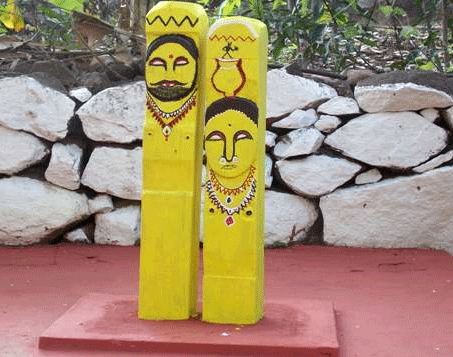
Judisum – the deities of Saora, installed at the entrance of the village
7. Lanjia Saora Development Agency (LDSA) Micro Project and Area of Study
The LSDA has been registered under Society Registration Act No. XXI of 1860 with Registration No 152-13/1984 -85 dated 10 July 1984, under the aegis of ST and SC Development Department, Government of Odisha. Officially LSDA covers only 8 villages and 12 hamlets of Sagada Gram Panchayat (GP) at Puttasing, vide Resolution No 23270 dated 4 August 1984.
6574 persons including 3401 female (51.73%) of a total of 1294 Lanjia Saora families (as per 2012 survey) spread over a geographic area of 35 Sq. Km (8750 Acres approx.) of Sagada are covered under LSDA.
Lanjia Saora also live in the adjacent five other GPs, i.e. Puttasing, Talona, Jaltar, Chinasari, and Kulusing. Inclusion of only Sagada, and exclusion of other five GPs under the jurisdiction of LSDA often cause resentment and develop ill feelings amongst Lanjia Saora. There has been long standing demand for inclusion of these five GPs under the micro project.
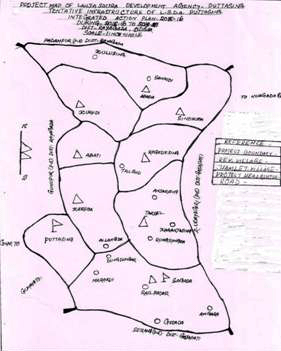
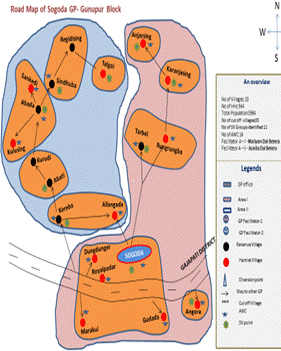
Figure-1: LSDA Project Area and Road Map of Sagada GP (Source: LSDA and ICDS, Gunupur)
LSDA undertakes a plethora of food and livelihood security related development activities as follows:
-
Agriculture : High Yielding Variety (HYV) paddy seeds, chemical fertilizers, pesticides and vegetable kits are supplied along with technical assistance from Department of Agriculture.
-
Horticulture : Cashew, mango, and orange plantation are encouraged. Podu cultivation has been stopped to a large extent.
-
Land development : Hilly and rocky lands of beneficiaries are developed with stone terracing and making them suitable for cultivation of crop; and creation of orchards, etc.
-
Irrigation : Large number of check dams, diversion weir, and field channels have been constructed on natural perennial cisterns to benefit farmers in irrigating their land.
-
Interior connectivity : Causeway, culverts, cement concrete roads for all whether communication have been constructed to enhance connectivity to interior areas.
-
Drinking water : Tube wells, spring based pipe water supply, water storage tanks and wells are constructed in each village
-
Electrification : 19 villages are covered under Rajiv Gandhi Gramin Bidyut Yojana and Biju Kutir Joyti Yojana for rural electrification.
-
Forest Right Act : 843 PVTG members are distributed with the title for 1574.10 Acres of land under individual claim, and 18 are under community claims for 54.35 Acres under Forest Right Act.
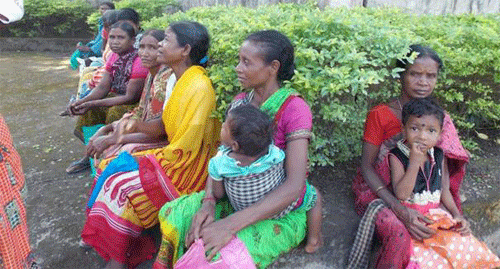
Informal chatting of Lanjia Saora women before a formal SHG meeting
-
Self Help Group (SHG) promotion: A total of 57 SHGs are functional in the LSDA area. Apart from facilitation of provision of revolving funds for marketing of minor forest produce (MFPs), four (4) SHG buildings have been constructed. Subsidies for tractor, pick-up vans and rice holler etc. are facilitated with required bank linkage.
-
Multi-purpose service center (MPSS) buildings: 11 such buildings are constructed and used for the purposes of pre-primary education, extension of health services, PDS distribution etc.. 874 persons under Antyodaya Anna Yojana, 6 under Annapurna and one APL cardholder receive their essentials commodities from these centers.
-
Idital (Art) training: Tribal youth are being trained on Idital painting (Saora wall painting) form by Tribal Development Cooperative Cooperation (TDCC) for which Integrated Tribal Development Agency (ITDA) has constructed a building at Gunupur. Lanjia Saora youths have been supported to undertake art training in BK Art College, Bhubaneswar for the conservation of the traditional Idital wall painting. Two women SHGs are supported with Rs1.5lakhs each for promoting Idital.

Idital – the famous Saora painting
Idital is a form of Saora paintings. These paintings have religious associations. These paintings are worshiped on various occasions like child birth, harvest, marriage, construction of new house, epidemics, and rituals for dead persons in the family, etc. These are made to appease Gods and ancestors whose displeasure would otherwise bring ill fate. These are normally drawn on the walls. Sun, moon, animals, trees, people etc., are repetitive motifs in these paintings. Icons on collection of foods, hunting, preparation and offering of food often find place in these paintings.
-
Educational (Girls) Complex, Kabera: The educational complex at Kabera has started functioning since 2008. It has 350 PVTG girl students reading in classes from I to X. Food and accessories are provided to the girls free of cost.
8. Government Schemes for Food and Nutrition Security
There has been a long tradition of food programmes in India. Many of India’s food security (-related) schemes, considered to be the largest in the world, due their vast outreach. These schemes safeguard various (age-) categories of population through life cycle approach, starting from conception in womb of the mother to cremation (even after death) of an individual, to cater to the Household food security. However, despite having this magnanimity of the welfare governments (both Center and State), every 3rd child in India is malnourished, and every second woman is anemic.
Existing Government Interventions (Life Cycle Approach)
| Beneficiaries | Schemes (National Flagship Programs) |
|
Pregnant and Lactating Women |
Integrated Child Development Services (ICDS), Reproductive Child Health (RCH)–II, National Health Mission (NHM) |
|
Children 0-3 years |
ICDS, RCH-II, NHM, IMNCI, Rajiv Gandhi National Crèche Scheme |
|
Children 3-6 Years |
ICDS, RCH – II, NHM, Rajiv Gandhi National Crèche Scheme |
|
Students 6-14 Years |
Mid-Day Meals, Sarva Sikhya Abhiyan |
|
Adolescent Girls |
Nutrition Programme for Adolescent Girls, SABALA, Kishori Shakti Yojana |
|
Adults |
Food for Work, Aam Admi Bima Yojana, MNREGS, Skill Development Mission, Women Welfare and Support Program, Adult Literacy Program, BPL Population Universal Public Distribution System, Antodaya Anna Yojana, Old and Infirm Persons Annapurna, Rashtriya Krishi Vikas Yojana, Food Security Mission, Safe Drinking Water and Sanitation Program, National Horticulture Mission, National Iodine Deficiency Disorders Conrtol Programme (NIDDCP), Nutrition Education and Extension, Bharat Nirman |
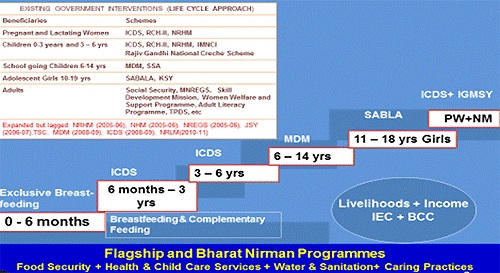
Figure -2: Existing Government Interventions (Life Cycle Approach) on Food and Nutrition Security
A few such key food security (-related) schemes, being implemented in the study area, are enlisted below.
8.1 National Food Security Act (NFSA)
National Food Security Act, 2013 has the objective to provide food and nutritional security, by ensuring adequate quality food, at affordable prices to people to live a life with dignity. This covers of up to 75% of rural population, and up to 50% of urban population for receiving subsidized food grains under Targeted Public Distribution System (TPDS). The eligible persons are entitled to receive 5 Kgs of food grains per person per month at subsidized prices of Rs. 3/2/1 per Kg for rice/wheat/coarse grains. The existing Antyodaya Anna Yojana (AAY) households, which constitute the poorest of the poor, will continue to receive 35 Kgs of food grains per household per month.
The Act also has a special focus on nutritional support to women and children. Besides meal to pregnant women and lactating mothers, during pregnancy and six months after the childbirth, such women are entitled to receive maternity benefit in cash.
The implementation of the scheme was delayed in Odisha as the administration took a long time in making the list error-free and excluding the ineligible applicants. However, since October 2015, the implementation has been accelerated though a few errors of inclusion and exclusion still exist.
In order to reduce such errors, and improving utilization and outreach of food grains, UNWFP has partnered with Government of Odisha to demonstrate a replicable model, with a package of technology-based solutions, in Rayagada.
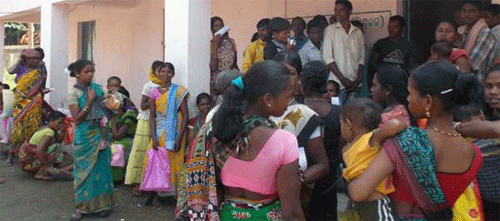
Lanjia Saora women receiving Ration-cards at Sagada MPSS building on 20 November 2015
8.2 Public Distribution System (PDS)
PDS is the largest outreach food distribution program in the world. It aims at making food and essential items easily available at subsidized price through government fair price shops across the country. The PDS has been criticized for being an ineffective program, with substantial leakages, and little impact on either reducing expenditure on poverty or malnutrition. The correlation between PDS performance and trends in the reduction of malnutrition does suggest the possibility of casual link. Harris and Kohli (2009). However, the same study also reveals that states, having done well in reducing undernutrition among children, are also the states with most extensive use of PDS.
Government of Odisha provides PDS rice @ Re.1/- per Kg. with effect from 1st February, 2013 to all beneficiaries of Rs.2/- per Kg. rice scheme operational since 1st August’ 2008. BPL as well as APL families get 25 Kg of rice per family per month in KBK districts.
8.3 Mahatma Gandhi National Rural Employment Guarantee Act (MNREGA)
The Mahatma Gandhi National Rural Employment Act (MNREGA) – 2005 aims at enhancing the livelihood security of people in rural areas by guaranteeing 100 days of wage-employment in a financial year to a rural household whose adult members volunteer to do unskilled work.
Works undertaken under MNREGA mainly constitute water conservation, rural connectivity, land development, drought –proofing, flood protecting, provision of irrigation facility to individual beneficiary, etc. which contribute vastly to food security in long run.
Major share of person-days of employment created under MNREGA constitutes participation of women and SC and ST families. The trend is also observed to be increasing, nationally, in last 3 years. While the average wage rate per day per person has increased from Rs121 in 2012-13 to Rs141 in 2015 -16, the average person days, however, is observed to be decreasing from 50 in 2012-13 to 38 in 2015-16.
However, it is observed that percentage of women worked under MNREGA in Sagada GP (Lanjia Saora) has decreased from 50% in 2012-13 to 47% in 2015-16, though it has an increasing trend in case of men.
MNREGA has been successful in increasing the minimum purchasing power for food security in families living below the poverty line. However, there is still a large majority of population that is unable to avail full 100 days of guaranteed employment. This study also noticed out migration of Lanjia Saora to Arunachal Pradesh, Assam, Maharashtra in search of jobs during lean period.
8.4 National Horticulture Mission
National Horticulture Mission has been launched in April 2005. This is implemented in 24 out of 30 districts of Odisha, including Rayagada. These 24 districts are identified in 4 clusters for development of 14 major horticultural crops. Government of India’s share is 85% and State Government’s share is 15%. This mission has a mandate to promote holistic growth of the horticulture sector through area-based regionally differentiated strategies. The potential of enhanced consumption of fruits and vegetables to contribute to nutrition security is high.
Consumption of fruits, though found to be low at the time of study, Lanjia Saora consume good amount of seasonal local fruits including mango, jack fruits, date palm, custard apple, pineapple, cashew, coconuts, etc. (Coconut plants were brought for the first time to the village some 35-40 years back). A particular sweet variety of yellow banana is famous in the area.
8.5 Rajiv Gandhi Scheme for Empowerment of Adolescent Girls (RGSEAG) – SABLA
Merging the erstwhile Kishori Shakti Yojana (KSY) and National Programme for Adolescent Girls (NPAG) schemes, the Rajiv Gandhi Scheme for the Empowerment of Adolescent Girls (RGSEAG), namely, SABALA, is being implemented since 2011-12, by Ministry of Women and Child Development (MWCD). SABALA aims to address the multi-dimensional problems of adolescent girls, in two age categories i.e. viz. 11-15 and 15-18 years, with strategic interventions. The scheme focuses on all out-of-school adolescent girls who would assemble six days a week at AWC. The others, i.e., the school going girls would meet at the AWC at least twice a month and during vacations/holidays. They receive life skill education, nutrition and health education, awareness about other socio-legal issues, etc. This gives an opportunity for mixed group interaction between school going and out-of-school girls, motivating the latter to join school.
Using the ICDS platform, the scheme provides an integrated package of services to the adolescent girls including: (i) Supplementary Nutrition; (ii) IFA supplementation; (iii) Health check-up and Referral services; (iv) Nutrition and Health Education; (v) Counseling/Guidance on family welfare, child care practices and home management; (vi) Life Skill Education and accessing public services; and (vii) Vocational training (for girls aged 16 and above) and skill development.
8.6 Indira Gandhi Matritva Sahyog Yojana (IGMSY) – a Conditional Maternity Benefit Scheme
This conditional maternity benefit scheme has focus on pregnant women of 19 years of age and above, excluding government employees who are entitled for maternity leave, for first two live births. Using the broad framework of ICDS programme, the IGMSY is implemented as a pilot intervention in selected districts. Rayagada is one amongst the selected districts.
Cash is transferred, based on the fulfilling conditions, to all pregnant and lactating women to contribute towards supporting health and nutritional needs. The scheme contributes to compensating the woman for wage loss that she might incur while caring for herself and the child. The scheme also prompts mothers to seek health services related to mother and child.
Each pregnant and lactating mother receives a total cash incentive of Rs. 4500/- between second trimester and till the child attains the age of 6 months subject to fulfillment of conditions laid down in the scheme.
8.7 National Health Mission (NHM) and other Health Sector Interventions
There are many health services under NHM and other health sector interventions that address malnutrition, including: (i) Immunization Programme; (ii) Care of the sick and new born child – at the community level through the Accredited Social Health Activists (ASHA), and at the institutional level through primary health care facilities; (iii) Universal Vitamin A administration; (iv) Pediatric De-worming and Anemia management; (v) Universal Iodization of salt programme and the national goiter control programme; (vi) School health programmes with iron Folic Acid (IFA) once a week supplementation and six monthly deworming; (vii) Nutrition Rehabilitation centres- for the sick and severely malnourished child; (viii) Programmes of adolescent health which address nutrition counselling and anemia; etc.
Decentralized bottom-up planning, robust computerized management information system, trained ASHA workers, flexible untied funds for local action, inter-sectoral convergence of sanitation and hygiene, nutrition, etc. activities, involvement of NGOs, etc. need-based features of NHM has enabled better delivery of health services at field level.
Maa Gruha i.e. special initiative for promotion of institutional delivery, tribal health camps in hard-to-reach areas having prone to malaria, tuberculosis, jaundice and child malnutrition, etc. (specially in PVTG habitats), assistance to ST/SC girls for nursing studies, etc. are being promoted by Government of Odisha. NGOs are also involved in reducing high incidents of maternal and child mortality in these PVTG areas.
Infants Mortality rate (IMR) i.e. 58 infants’ death per 1000 live births in Rayagada is slightly higher than state average (56), but much lower than many other nearby districts within KBK region. While neo-natal mortality rate in Rayagada (28) is much lower than state average (37), alarmingly, the post-natal mortality rate in Rayagada (30) is higher than state average (19). AHS (2012-13).
8.8 Total Sanitation Campaign (TSC)
Lack of adequate sanitation is a pressing challenge in India, more so in tribal areas. Sanitation-related diseases take a heavy toll of children’s lives. These diseases are a result of faecal matter entering the food chain at any of the many points of vulnerability.
”While, prevalence of various nutritional deficiency disorders may be attributed to poor nutritional status, the prevalence of various morbidity patterns may be attributed to the unhygienic condition of living.’ Patro S and Sahu R (2012).
In addition to an inadequate dietary intake, open defecation and poor hygiene contribute to adverse nutritional outcomes by increasing the likelihood of diarrhea and gastro-intestinal disorders including tropical sprue or environmental enteropathy. While many factors contribute to undernutrition, new evidence from the World Bank study in Cambodia shows that “in communities where all households defecate in open, children under age of five are 2 to 3.6 cm shorter than children living in communities where no one defecates openly”. UNICEF (2015).
TSC has a community led approach that focuses on Information, Education and Communication (IEC), minimum capital incentives only for poor households, post contraction and usage, Nirmal Gram Puraskar, etc. to accelerate achievement of total sanitation outcomes. The central Government under its ‘Swatch Bharat Mission’ currently stress a lot on sanitation. The TSC concentrates on promoting behavior change.
8.9 Indira Gandhi National Pension Schemes
Indira Gandhi National Old Age Pension Scheme is provided to BPL individual, aged 60 years and above, who gets Rs200/- per month and Rs500/- per month for 80 years and above. Payment of pension is made by 7th of the month. Similarly, Indira Gandhi National Widow Pension Scheme provides Rs 300/- per month to BPL widow of 40 years and above, and Rs500/- for those 80 years and above. Likewise, Indira Gandhi National Disability Pension Scheme provides Rs300/- per month to BPL individual aged 18 years and above with more than 80% disability, and the amount increases to Rs500/- for those 80 years and above.
8.10 National Family Benefit Scheme
The National Family Benefit Scheme provides for lump sum cash assistance to BPL families in the event of death of a bread-earner (member of the household whose earnings contribute substantially to household income) between age group of 18-60 years. The bereaved family receives lump sum of Rs20,000/-. The assistance is provided in every case of death of a bread-winner in a household. The payment is made after consulting the surviving head of the bereaved household. Efforts are made to ensure that the payment has to be made within four weeks of the death of the breadwinner through the local Panchayat.
8.11 Swarnajayanti Gram Swarozagar Yojana (SGSY)
The scheme is being implemented since 1999 by providing assistance to BPL families to bring them above the poverty line. Self Help Groups are formed in the locality. They were supported through credit mobilization, capacity building, training and income generating assets. The activities range from minor irrigation, poultry, dairy, piggery, goat rearing, fishery, bee keeping, leather products, handicrafts, bamboo products, readymade clothes, bricks making, tractors, transport vehicles, leasing of small sand Ghats, leaf cup plate making units, dal processing units, etc. Activities are taken up individually or in group.
Effective self-employment does not only focus on selection of right activity but also its execution in right manner. It involves the whole process of project management including planning, procurement of raw materials, production, marketing of goods, managing the finance, etc. The district units of Orissa Rural Development and Marketing Society (ORMAS), namely, District Supply and Marketing Society (DSMS), Rayagada help facilitating such SGSY activities, preferably in groups i.e. SHGs, by undertaking feasibility studies and establishing financial linkages with nearby banks. Many of the identified key products, consumables as well crafts, have been marketed through ORMAS’s own brand and also having franchise with established brands like Dabur. Tribal beneficiaries are reported to have been benefited with increased income through these continued professional interventions. Recently, these activities are covered under Odisha Livelihood Mission.
8.12 Mid-Day Meal Scheme (MDM)
|
Cooked meal with a minimum content of 450 K Calories and 12 grams of protein per child per school day is provided under MDM. More than 12 Crore Indian children are covered under MDM scheme, which is the largest school lunch programme in the world. There is evidence that MDM has indeed enhanced enrolment of children (especially girls), reduced drop outs in schools as well as provided nutrition supplement to school going children. Moreover in the disadvantaged areas, MDM has been able to provide at least one meal to the children in the school. Performance of MDM varies from state to state. Various alternate models including involvement of women SHG, Panchayats, NGOs for centralized and decentralized food preparations, etc. have been experimented for smooth and improved implementation of MDM scheme. LPG cylinders are provided for cooking of meals. However, quality of education and quality of food remain matters of concern. High increase in the price of pulses (dal), in 2015 - affected negatively the quality and quantity of pulses / dal being served in the schools. It is observed that pumpkin, cucumber, beans are grown on the back yard kitchen garden in almost every household. Children gave favorable opinion on consumption of those vegetables in home. |
|
8.13 Emergency Feeding Programme
Emergency feeding programme is targeted for old, infirm and destitute persons belonging to BPL category by providing food in their distress conditions. The objective is to provide one square meal a day to the above mentioned persons on a sustained basis to cope with the food insecurity cycle.
The programme was introduced in May 2001 by Government of Odisha in 8 districts of KBK region. Cooked food containing about 200 grams rice, 40 grams of dal (pulse) and 30 grams of vegetables are provided as a meal to each beneficiary daily. Rice is allocated to State Government under Revised Long Term Action Plan (RLTAP) and Special Central Assistance.
8.14 Integrated Child Development Services (ICDS)
|
More than one third (37%) of World’s stunted children below 5 years are Indian. Within India, stunting is highest (54%) among tribal children. Odisha has 57.9% of stunted tribal children (rural) under five years of age, 29.3% are severely stunted. 75.6% tribal children (rural) in Odisha are below poverty line. Studies reveal that maternal stunting and inter-pregnancy interval were key predictors of stunting and severe stunting in tribal children. Additionally, maternal illiteracy, birth order, gender and poverty increased the odds of severe stunting in tribal children. UNICEF (2015) |
India developed its first National Policy for Children in 1974 during the 4th plan, which focused on accelerating the basic minimum services for the children. Subsequently, the ICDS scheme was launched on 2nd October 1975 (during the 5th plan), which aimed at the holistic development of the children below 6 years along with the pregnant women and lactating mothers, with the following package of services, and with existing focus on first 1000 days:
Table – 1 Packages of Services under ICDS
|
Package of Services under ICDS at AWCs |
Beneficiaries |
|
|
The critical window of opportunity, for preventing malnutrition, exists during the 1,000 days between conception and a child’s second year of life. Staying well-nourished during the first 1,000 days can pave the way for a strong, healthy, productive future. Evidence shows that optimal nutrition during this time can have a lasting impact on a child’s growth, learning, and future productivity.
Chronic malnutrition at this period may imperil cognitive and physical development process, and the loss is irrevocable. Most of ICDS activities occur at AWC itself, where children above 3 are brought and by the time the child comes there, a crucial period to control undernutrition has elapsed.
Infant and Young Child Feeding Practices (IYCF) have shown greater potential impact on child survival. Government of Odisha has launched an IYCF initiative in the state as Project SURAKHYA. This initiative looks at strengthening interpersonal communication of frontline functionaries for counseling mothers and care givers on improved IYCF practices that include, (a) Survival, growth and development of children, (b) Early initiation of breastfeeding within 1 hour of birth, (c) Exclusive breastfeeding till six months of age, (d) Complimentary feeding practices from the 7th month, (e) Breastfeeding till 2 years of age. All pregnant and lactating women and adolescent girls are counseled and made aware of the IYCF practices. The Positive Deviance Approach Äme Bi Paribu’, adopted in various tribal districts by the Government of Odisha, with the support of UN agencies, had also yielded good result.
Nutrition and Health Education (NHED) forms one of the key elements of the ICDS scheme. Women in the age group of 15-45 years are given information on their health, nutrition and developmental needs. These are imparted through counseling sessions during home visits, fixed immunization days, Village Health and Nutrition Day (VHND) or Mamta Diwas, mothers’ meetings, Gram Sabha and during the panchayat meetings in the community. NHED is also promoted through available print, electronic, and folk media.
Rayagada is one amongst the 15 ‘High Burden’ districts of Odisha covered under the ‘’Nutrition Operation Plan’ to accelerate the pace of underweight reduction. Greater focus is given to support convergence of health and nutrition services at the grass root level. Important instructions are laid down for improved feeding practices including diet diversification and micronutrient supplementation. Integrated Behavioral Change Communication and early childcare education are parts of the strategic interventions.
8.14.1 Supplementary Nutrition
The Supplementary Nutrition is one of the six service packages provided under ICDS. The provision of supplementary nutrition is primarily designed to bridge the gap between Recommended Dietary Allowance (RDA) and Average Daily Intake (ADI). Supplementary Nutrition is given to the children (6 months – 6 years) and pregnant and lactating mothers.
Recommended Dietary Allowances (RDA), Average Dietary Intakes (ADI), Gaps and Supplementary Nutrition (SN) through ICDS for various age groups are indicated below.
Table-2: RDA, ADI and Supplementary Nutrition under ICDS
|
Age Group |
Nutrients Needs ad Gaps |
Energy (K Cal) |
Protein (Gm) |
|
1-3 years |
RDA |
1240 |
22 |
|
ADI |
687 |
18.6 |
|
|
Gap |
553 |
3.4 |
|
|
ICDS SN Norm* |
500 |
12-15 |
|
|
4-6 years |
RDA |
1690 |
30 |
|
ADI |
978 |
26.5 |
|
|
Gap |
712 |
3.5 |
|
|
ICDS SN Norm* |
500 |
12-15 |
|
|
Pregnant Women |
RDA |
2175 |
65 |
|
ADI |
1654 |
45 |
|
|
Gap |
521 |
20 |
|
|
ICDS SN Norm |
600 |
18-20 |
|
|
Lactating Women |
RDA |
2425 |
75 |
|
ADI |
1852 |
46.7 |
|
|
Gap |
573 |
28.3 |
|
|
ICDS SN Norm |
600 |
18-20 |
|
|
‘* For severely underweight children (1-6 years) |
800 |
20-25 |
|
The nutritional norms under ICDS are revised by the MWCD, vide GoI letter No. 5-9/2005-ND-Tech Vol. II dated 24 February 2009. The revised guidelines, thus, issued by the Ministry, have been subsequently been endorsed by the Hon’ble Supreme Court by its Order dated 22 April 2009. The revised feeding and cost norms under Supplementary Nutrition Programme are as under:
Table-3: Revised Feeding and Cost Norms under Supplementary Nutrition Programme
|
Sl. No. |
Category |
Revised feeding & nutritional norms (per beneficiary per day |
Revised cost norms (per day per beneficiary) |
Re-Revised cost norms (per day per beneficiary) * |
|
|
Calories (K Cal) |
Protein (g) |
Rupees |
Rupees |
||
|
1. |
Children(6-72 mts) |
500 |
12-15 |
4.00 |
6.00 |
|
2. |
Severely malnourished children (6-72 mts) |
800 |
20-25 |
6.00 |
9.00 |
|
3. |
Pregnant women and Nursing mothers |
600 |
18-20 |
5.00 |
7.00 |
‘* Under the Strengthened and Restructured ICDS, these rates have been revised to Rs.6.00, Rs.9.00 and Rs.7.00 per beneficiary per day for children (6-72 months), severely malnourished children (6-72 months) and pregnant women and nursing mothers, respectively.
Take Home Ration [THR] is given to pregnant and lactating mothers, children from 6 months to 3 years, as they do not attend the AWC on a daily basis. The severely malnourished children of 3-6 years are also given THR over and above Hot Cooked Meal.
Government of Odisha has taken an in-principle decision to give Ready to Eat [RTE] i.e. wheat-based Chhatua in the form of THR to all eligible beneficiaries as it will ensure that it goes to the intended beneficiary and not entered the family kitty in which case food ration gets diluted.
In the study area i.e. Lanjia Saora habitat (Puttasing sector), as per the data in the MPR of ICDS Gunupur for about last two year i.e. 2014 and 2015, almost all children received timely their due supplementary food ration only with a temporary disruption in November 2014 when supply of supplementary food got a bit delayed.
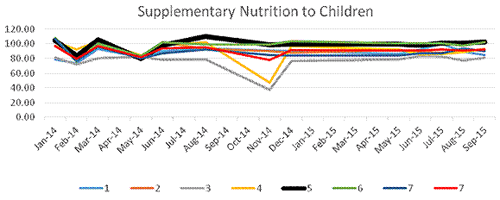
Figure - 3: Percentage of Children Covered under Supplementary Nutrition in ICDS Gunupur
It is also learnt through PRA exercises that adult men member hardly consume the food given to intended beneficiary in Lanjia Saora community. Lanjia Saora treats its women and children as important social and economic assets. They are loved, respected and allowed a great deal of freedom. Children from a very tender age also start to help their parents in all works and develop self-sufficiency. Lanjia Saora says, ‘Life is not worth living without children’.
8.14.2 Growth Monitoring and Promotion
Growth monitoring, nutritional surveillance and analysis of the nutritional status of children are imperative for assessing the impact of the health and nutrition related services. 'Mother and Child Protection Cards' are maintained for all children below six years. Their growth is charted both to detect growth faltering, stagnation and to assess their nutritional status, which aids in assessing the utilization of current strategies and helps in community mobilization to enable better childcare practices at home.
The MWCD, GoI has adopted 'Weight for Age' WHO Standards for nutritional assessment of children at the AWC and has revised the Growth Monitoring Charts. The New Growth Chart has three colour tracks in contrast to the earlier classification of Normal, Grade I, Grade II, Grade III, and Grade IV. 'Normal children' are represented by the green track. In the New Growth Chart, the lines have been shifted and Grade I and Grade II have been merged together (now termed as 'moderately underweight'), shown by a yellow track. Below the yellow track there is an orange track, which comprises Grade III and Grade IV children (now termed as 'severely underweight'). Severely underweight children are severely malnourished, and need special attention.
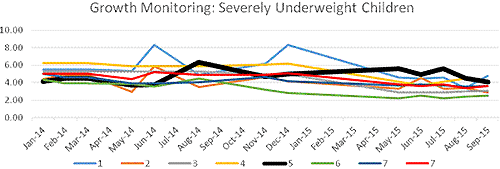
Figure - 4: Percentage of Severely Underweight Children in ICDS Gunupur
Growth monitoring data, vis-a-vis data on Supplementary Nutrition programme, reveal that there were more number of severely underweight’ children of Puttasing sector, as compared to those in other sectors, in the same Block where service delivery mechanism under ICDS remain similar. In 2015, the number of severely underweight children in Puttasing sector continued to remain higher than that of the average of number of severely underweight children in ICDS project. Other non-Lanjia Saora sectors nutritional status of children was rather found comparatively better.
9. Findings and Analysis
The study reveals that there is no straightforward positive relationship between performance of supplementary nutrition programme (SNP) and outcomes in terms of reduction of malnutrition. (SNP, of course, attracts children and mother to come to AWC where in pre-school and Nutritional Health educations are provided). Despite regular supply of food under SNP in Puttasing sector, over a period of two years under reference, the growth monitoring data reveal higher (about 1% and more) percentage of children as severely underweight, as compared to other adjacent sectors where coverage of children under SNP was comparatively less owing to some other socio-economic reasons including less attendance of mothers in AWC, etc.
|
Percentage of Children (below 6 Yrs) Covered under Supplementary Nutrition in Gunupur ICDS Project |
|||||||||||||
|
Sector |
Jan-14 |
Feb-14 |
Mar-14 |
May-14 |
Jun-14 |
Aug-14 |
Nov-14 |
Dec-14 |
May-15 |
Jun-15 |
Jul-15 |
Aug-15 |
Sep-15 |
|
Puttasing |
105.00 |
83.87 |
105.57 |
80.19 |
97.77 |
110.47 |
98.56 |
99.24 |
99.85 |
98.10 |
101.43 |
101.11 |
102.63 |
|
Average |
97.24 |
79.66 |
97.02 |
82.07 |
93.80 |
95.67 |
78.37 |
91.39 |
90.63 |
90.92 |
92.29 |
91.27 |
92.28 |
|
|
|
||||||||||||
|
Percentage of Severely Underweight Children Based on Growth Monitoring in Gunupur ICDS Project |
|||||||||||||
|
Sector |
Jan 14 |
Feb-14 |
Mar-14 |
May-14 |
Jun-14 |
Aug-14 |
Nov-14 |
Dec-14 |
May-15 |
Jun-15 |
Jul-15 |
Aug-15 |
Sep-15 |
|
Puttasing |
4.16 |
4.52 |
4.50 |
3.69 |
3.77 |
6.35 |
4.70 |
4.98 |
5.60 |
4.95 |
5.60 |
4.48 |
4.10 |
|
Average |
5.00 |
5.00 |
4.99 |
4.41 |
5.23 |
4.91 |
4.91 |
5.09 |
3.80 |
3.60 |
3.80 |
3.40 |
3.60 |
Figure - 5: Percentage of Children Covered under Supplementary Nutrition, and Percentage of Severely Underweight Children in Puttasing Sector of ICDS Gunupur
It was observed that food and feeding practices among tribal household are poor. Factors like malaria, poor hygiene, and open defecation, etc. contribute adversely to the nutritional outcomes by increasing gastro-intestinal disorders and diarrhea cannot be ruled out.
The average dietary intake of Lanjia Saora in the study area, Sagada and Puttasing GP, is comparatively less, as is also evident from the findings that despite having regular and adequate supply of supplementary nutrition, which only bridges the gap, the rate of malnutrition (severely underweight children) even with in the same ICDS project of Gunupur, is high, as compared with other sectors/ GPs where Lanjia Saora population is fairly less.
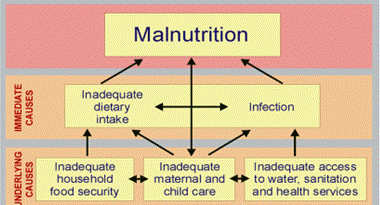
Nutritional anemia is a major problem for women in India, more so in tribal belt. Maternal malnutrition is predominantly a serious health problem among the tribal women especially for those who have closely spaced multiple pregnancies. Dietary habits of most of the tribes in India are not satisfactory. Tribal diets are generally grossly deficient in calcium, Vitamin A, Vitamin –C, riboflavin and animal proteins. From inception to termination of pregnancy no specific nutritious diet is consumed by women. The consumption of iron, calcium and vitamins during pregnancy is poor. Kshatriya G (2014).
Nutritive value of the diet of pregnant women is one of the important factors, which would directly affect the out-come of pregnancy. Many food taboos prevalent in the society either allow or prohibit the expectant mothers to consume some food.
The study finds food restrictions for Lanjia Saora mother immediate after childbirth for about two days when she is given no food or very less food. It is believed that having food at this time would lead the woman to have a large belly. There are some restrictions during pregnancy too. Restricted food items include banana, coconut water, few varieties of wild mushroom, etc. These food items are believed to either cause cold and cough to mother or would lead to abortion or would lead the child to become cross-eyed.
9.1 Child Malnutrition: A Community Issue
The Community-Based Management of Acute Malnutrition (CMAM) approach enables community volunteers to identify and initiate treatment for children before they become seriously ill. Caregivers provide treatment for the majority of children with severe acute malnutrition in the home using Ready-to-Use-Therapeutic Foods (RUTF) and routine medical care. When necessary, severely malnourished children who have medical complications or lack an appetite are referred to in-patient facilities for more intensive treatment. CMAM programmes also work to integrate treatment with a variety of other longer-term interventions. These are designed to reduce the incidence of malnutrition and improve public health and food security in a sustainable manner.
CMAM is implemented in any area where at least 10% of children under 5 are moderately malnourished (low weight for height) and there are aggravating factors present. Aggravating factors include generalized food insecurity, widespread communicable diseases and high crude death rate. CMAM targets children under 5 years old and their families, but the whole community is involved. Community leaders, volunteers, health staff and families participate in the screening, care and follow up of children with malnutrition.
9.2 Food Habits that affect Food Security and Malnutrition
The study took note during interactions and PRA exercises that with the influence of Christianity over the years, festivities in Lanjia Saora have been reduced mainly to Christmas. Other local festivals are slowly loosing their importance. However, Guar i.e. laying of a stone slabs in memory of the deceased is still in practice. Guar ceremony is observed after 2 or 3 successive Karja rituals. Varieties of food, being an integral part of festivals, are also becoming out-of-the-way to tribal society. Many nutritious food items have started missing from the tribal cuisine.
The study also noticed that recipes from other states like Arunachal Pradesh, Assam etc. have started influencing cooking in some of the kitchens due to the culinary skills of women, from those states, who are married to the migrant Lanjia Saora who temporarily went out in search of job in construction sites or tea gardens, during the lean period. Fast food like maagi noodles, kurkure, buns, confectionaries, oily and fried items, etc. have been sizably used as snacks.
External influence, persuasive publicity of various food brands and their penetrative market reach (e.g. pepsi, cocacola, maggi, ruchi masala, kurkure, etc), forced food baskets (rice and wheat) under various government schemes, less in demand and non-availability of traditional food items, have brought in effective changes in the food habits of Lanjia Saora. Decreased physical activity and increased fat in food habits lead tribal susceptible to various metabolic risks factors affecting negatively to their already poor health status.
Not only because of diversity in food consumption but also due to the changes, which are coming up due to acculturation, affecting their life style including food habits has made the tribals vulnerable to those non communicable diseases, which were not common among them. It was observed that a considerable portion of tribal population was suffering from the stress of undernutrition. It is interesting to note that with the stress of undernutrition they are also susceptible to hypertension. Kshatriya G (2014).
The prevalence of hypertension was higher in Odisha, and has increased significantly amongst the tribal adult population in Odisha (53.7% males and 48.8% female). Prevalence of hypertension is higher amongst older adults, compared to young adults and in men as compared to women. Cases of cardiovascular diseases, peripheral vascular diseases, kidney diseases, etc. are many amongst the tribal population. The prevalence of tobacco and alcohol consumption amongst ST men was quite high in Odisha i.e. 80.4% and 69.1% respectively. Consumption of tobacco and /or alcohol in any form has negative implications on health causing diseases such as cancer and tuberculosis. (NNMB reports)
It is learnt from medical doctors of the local hospitals (both government and missionary) that more number of cases of hypertensions, malfunctioning of kidney, diabetics, etc. are being reported. The prolonged treatment puts pressure on their little savings, if any. Additionally, the unproductive expenditure on tobacco and alcohol coupled with subsequent repetitive visits to available health facilities forces them to remain absent from their work place on those medical-days, which pushes them into further misery.
9.3 Uncultivated Food – an Important Chunk of Tribal Diet
Uncultivated food constitutes a very critical source of food and nutrition for tribal and a part and parcel of their food habit. Tribal communities used to have a symbiotic relationship with nature i.e. forest which used to cater to their basic food need. Technical analysis of these cultivated forest foods shows their high nutritive values. Traditional knowledge also puts a tab on what to eat, how to eat, and what not to eat. These organically grown foods hardly raised any concern on food safety issues as it is raised on the cultivated food grown with additives and chemical fertilizers.. These wild species of foods are supposed to be more resilient, and seem to be an alternate choice (a fallback option) in the age of climate change which has tremendous adverse impact on cultivated food production and other reasons such as a break in supply chain of trade in of cultivated food, with natural or man-made causes, disrupting the food intake of tribal. Cultural significance of these uncultivated foods also enriches the dignity and self-esteem of tribe who are, at times, looked otherwise.
However, such vast potential alternate (existing) food base for tribal has never been explored or found a place in policy discussions on food security. Gift of the nature that used to feed the tribe for ages has been ignored ruthlessly. Ulterior motives of cunning policy makers in encroaching, under-estimating and replacing such nutritious, healthy and available tribal diet cannot be ignored either. The mainstream food economy mostly considers the consumption of wild and uncultivated foods as a sign of economic and cultural backwardness.” Living Farm (2014).
The study reconnoiters hundreds of varieties of uncultivated foods consumed by tribal. Though elderly people of the PVTGs expressed their concern during the PRA exercises on decline of the availability, mainly, due to declining in forest coverage, elephant herds, forest fire, etc. In case of LSDA area, the study finds Lanjia Saora has developed apathy towards these uncultivated foods as compared to their counterparts in other non-LSDA area. 7 out of 10 girl students interviewed on the spot in a Lanjia Saora village could not respond correctly 5 commonly available uncultivated foods in the area. Interestingly, a schoolteacher revealed not to have tried local millets for about last 10 years. Restrictions of consumption of traditional snacks are imposed on the inmates in Ashram schools. Probable threat of food contamination is argued as reasons for not letting the traditional snacks/ food to be consumed by young children even in their own locality. The wild fruits and nuts, which a child would have enjoyed otherwise, are somehow kept apart (the story of tribal students in residential institutes in cities is obviously even worse, and is not discussed here).
However, PVTGs (excepting in LSDA area) were found to have continued dependence on uncultivated food depending on their seasonal availabilities. This too got reflected in the 24 hours recall method while measuring their dietary diversity. The study could manage to note a few varieties of mushroom, tubers, greens, fruits, nuts, flowers, leafs being collected and consumed, in non-LSDA area. Children in those hamlets are found to be cherishing their experiences in the process of collection and consumption.
PVTGs revealed very eloquently that the development administration, led by the current district Collector, stress upon the tribal to continue to retain the age-old time-tested healthy practices and to regain their self-esteem. Interestingly, at least two dozens of verities of aboriginal paddy grown in the tribal area are collected and being exhibited in the Sanskruti Bhawan at Rayagada.
10 Conclusions
-
A number of development programmes covering all age categories of population are implemented in the area to ensure food and nutrition security. While physical targets are achieved, numbers of beneficiaries are covered, funds have been spent; desired outcome do not align with the output indicators.
-
Despite having special micro project over three decades, additionally with regular and adequate delivery of supplementary food under ICDS, implementation of various food and livelihood security schemes, the percentage of severely underweight children below 6 years are found to be comparatively high in Lanjia Saora villages of Puttasing sector (in Sagada GP) than in the nearby sectors where neither such special micro project exists nor coverage under supplementary nutrition is so high.
-
Food restrictions related social taboos, affecting the nutritional status of mother and child, do exist in Lanjia Saora community, despite having years of developmental interventions, series of social awareness campaign and health and nutrition related behavior communication change strategies, etc.
-
There have been quite a lot of investments on Lanjia Saora villages through the special projects. Lanjia Saora is exposed to developmental world on many fora. External inputs (including food) have removed many genuine and pristine practices from them.
-
Lanjia Saora have been weaned away from local millets over the years. The food habits have been changed. An apathy in production and consumption of those millets and some other cereals, crops has developed due to less demand and poor marketing network for surplus, if any.
-
The current district administration has been putting efforts in promoting tribal culture including their food habits, agricultural practices, etc. to generate interest amongst the local citizens in general and researchers and concerned functionaries in particular.
-
Though it is claimed that there is no (or hardly any) alcohol consumption in Lanjia Saora villages due to missionaries’ intervention and social mobilization, many cases of drinking (of country liquor) and tobacco chewing were observed during the study period.
-
Participation of women of Lanjia Saora in MNREGA works over last four years has been reduced by four percentage despite increase in wage rates to an extent of nearly 50%.
-
Quality of food served as hot cooked meal under Mid-day Meal scheme needs improvement. Vegetables and protein (dal) contents in a meal should be increased.
-
Hygiene in respective schools and AWCs needs improvement. Households are covered under Swatch Bharat Mission, however require higher degree of awareness and compliance.
-
While 35 Kg of rice per household is reported as received by Lanjia Saora, issues of occasional supply of bad quality of rice and temporary delay were raised. Such cases are normally resolved with intervention and coordination of LSDA with Block officials.
-
Consumption of uncultivated food has its significance in PVTG’s food basket. Seasonal mushrooms, tubers, green leafy vegetables, varieties of wild fruits and nuts are collected and consumed by Lanjia Saora. Consumption of these uncultivated foods has thankfully not seen as something inferior by many excepting a few in LSDA area.
11 Recommendations
-
Strong coordination amongst various departments is required for convergence of already existing programme interventions in the area. It is learnt that Odisha Tribal Development Society (OTDS) has been formed with prime objectives of providing support for planning, implementation and monitoring of tribal development programmes through required technical inputs and capacity building. OTDS may start functioning in the field in reality.
-
Comprehensive planning may be done by OTDS for supporting ST families with viable livelihood options. Around 13 specific land and non-land based livelihood focus areas have been identified. It has been decided that the OTDS would sign MoUs with MGNREGA, National Rural Livelihoods Mission, Odisha Livelihoods Mission, National Horticulture Mission, Watershed Mission and Forest Development Corporation for convergence of various program activities including livelihood and housing schemes i.e. Biju Pucca Ghar and Indira Awas Yojana (IAY), etc.
-
Regular monitoring and review of these activities may be conducted with representation, including women, from Lanjia Saora villages. This would keep track of ongoing progress, analyze the constraints, alert the management and allow to take timely corrective measures, if any,
-
Systematic and comprehensive documentation of uncultivated food along with nutritional and medicinal property, cultural significance, constraints and conducts in accessing these by tribal, may be organized. Uncultivated foods may get an entry in the policy discussions.
-
Regulated food prices: Improved purchasing power of people and control food prices enable tribal to have better accessibility to food. High increase in the price of dal (pulses) in 2015 compelled tribal household to stay away from it for quite a long time. Programs like MDM also suffered due to increased price of pulses (dal). Alternate arrangements for local varieties of processed Kandula (pulses) may be kept in place, at least as a substitute, to arrest drastic drop in protein intake by children.
-
Enhanced local food production: Policies that encourage food productivity by promoting land use, and diverse cropping patterns, especially in accessing proteins, oils and micro-nutrients, other than grain-based calories alone, are important for enabling tribal to have balanced diet to counter the dietary pattern of high cereal intake with low or no protein. There is a need for enhancing production particularly for pulses, fruits and vegetable and ensuring their affordability and availability at the household level.
-
Enhancing local processing: Promotion of local food processing to support the wide range of food security measures would stimulate local economic activity, strengthen community based organizations, especially SHGs and improve quality of local governance over these programmes. The hot cooked meal under MDM scheme by women SHG is an example. Processing various food items from the seasonally available forest products would not only provide employment to tribal but also regain their lost interest on homegrown food items slowly. Dal processing units, fruits processing unit, Quality Chhatua making units (with buy-back arrangement with ICDS), etc. may be developed in the area with the involvement of women SHGs by DSMS/ ORMAS.
-
Disaster Risk Reduction on nutritional vulnerabilities: Food supplementation programmes are needed in natural calamities and other situations associated with increased nutritional stress like (flash) floods, drought, conflict situations of extreme hardships (some of the study areas i.e. habitats of PVTGs in Rayagada are Naxal affected too), starvation or hunger situation etc. Necessary action would include community kitchens, extending midday meal provisions into holidays and vacation months, extending food supplementation programmes to a second meal per day and so on. Pre-positioning of food and setting up of grain banks would support the tribal during lean and food scarcity seasons.
-
Community participation: Mothers committees in respective tribal villages under ICDS would be of great help. The Positive Deviance Approach, organized in tribal districts in the past, on ICDS platform, in addressing malnutrition had shown good result. It may be re-worked out.
-
Organizing nutrition delivery - through common kitchen: There is a possibility of bringing together the preparation of food supplements for school children, adolescent girls, pregnant and lactating women and children between 6 months and 6 years, under one administrative and implementation mechanism, along with enhanced financial and human resources. This would make it possible to improve quality, food safety and hygiene and save on costs. This would involve locating the AWC in the school or in the close vicinity of the school, as well as putting in place foolproof arrangement of trained cooks who can either be individuals or a group of dedicated women group in the area. The labour cooperatives may play a significant role in such attempts. The recently popular Áhaar’ scheme of Government of Odisha in urban areas are rather more needed in tribal areas, MNREGA sites. While women would be engaged in community food preparation, others can provide backward and forward support by providing locally grown vegetables, condiments and spices through micro entrepreneurial activity, and ensuring transport of food, if service is extended to a site which a bit away from the food preparing/ processing unit.
-
Enhancing livelihood options for women through MNREGA: It is necessary for ICDS as well as MGNREGA to converge their efforts in order to have crèche facility to take care of the children of those women working under MNREGA. Such a crèche can be directly linked to AWC. Corrective actions may be taken by studying the reasons for decrease in women’s participation in MNREGA in Sagada GP. Safety, security and provision of suitable women friendly works coupled with facilities of care and services for children may enhance women’s participation in MNREGA work force. The direct economic benefit would empower the tribal women even in ensuring better education, health care, and enhanced nutritional status of their children.
-
Strengthening livelihood through NRLM: The NRLM seeks to reduce poverty among rural BPL families by focusing on women’s SHGs and youth, through promotion of diversified and gainful self-employment and wage employment opportunities to provide appreciable increase in income on a sustainable basis. In the long run, this may promote broad based inclusive growth and reduce disparities and improve food security safety nets for BPL families, especially women. NRLM, along with the National Skill Development Mission, would link skill development and vocational training to promote future livelihood and improved food and nutrition security.
References
-
Harris and Kohli, 2009, Notes on the differing’ states’ of child undernutrition in rural India. IDS Bulletin, 40 (4).
-
Census (2011).
-
Annual Health Survey –AHS- (2012-13).
-
Patro S and Sahu R (2012). Asian Journal of Home Sciences, 7(1), 55-58
-
UNICEF (2015), Nourishing India’s Tribal Children
-
Kshatriya G (2014). Journal of Environmental and Social Sciences, 1 (1).
-
Living Farm (2014). Forest as Food Producing Habitat
Acknowledgement
I thank Prof. (Dr.) Rita Ray for her continued guidance and inspiration for this study. While I sincerely acknowledge the support of senior officials in government, I remain thankful especially to the Collector and the district administration of Rayagada for their support in enabling me to access the remote tribal habitations as well as field-based data.

